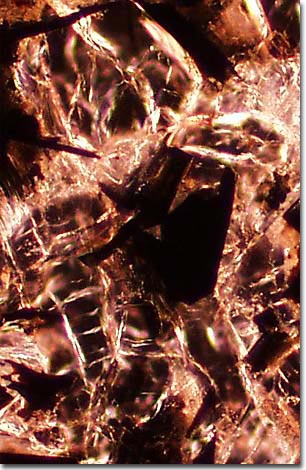Darkfield Microscopy Image Gallery
Apollo 11 Moon Rock
On July 20, 1969, Apollo 11 astronauts Neil Armstrong and Buzz Aldrin landed their lunar module (the "Eagle") in the Sea of Tranquility on the Moon. They recovered a number of rock samples from this crater and returned them to Earth, including the lava basalt illustrated below.

This photomicrograph was taken of a thin section of the Moon rock under darkfield illumination. Inclusions in the rock appear as ice-like crystalline patterns surrounded by an amorphous matrix.
Between 1969 and 1972 the National Aeronautics and Space Administration (NASA) successfully landed 12 astronauts on the lunar surface. The astronauts who visited the Moon carefully collected 2,196 documented samples of lunar soils and rocks weighing a total of 382 kilograms (843 pounds) during approximately 80 hours of exploration. It is important to note that these samples were gathered from a harsh lunar environment that included wildly fluctuating temperatures in an almost complete vacuum, dangerous solar radiation, and the uncertainty of return to Earth due to equipment failure.
Geologists hoped that exploration of the lunar surface would establish its composition, internal structure, geological history, and evolution. In this respect it was thought that the moon would serve as a model for the early history of the earth and the rest of the solar system. However, based on Apollo-missions research, it has been determined that the moon is far more complex than previously thought. The earth's only satellite, which was formed approximately 4.6 billion years ago along with the rest of the planets, has partially melted and differentiated during its history.
The lunar surface can be roughly divided into two domains. About half of the Moon's surface is covered by the dark lunar mares (latin for seas) or lowlands. The photomicrograph illustrated in our banner is derived from a polished thin section of a lunar lava basalt sample collected from the Oceanus Procellarum mare region by Apollo 12 astronauts. Mare basalts are volcanic lavas rich in iron and titanium oxide minerals that formed when molten rock from the Moon's interior came to the surface and flowed over large areas.
